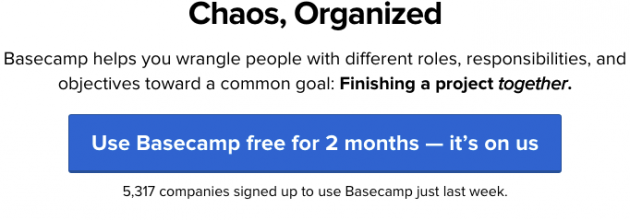
3 Questions That Will Help You Understand Your Customers Better

There’s an old sales legend about a hot-shot salesman who tried to sell a home-heating system to a little old lady. He started his pitch by telling her everything there was to know about BTU’s, construction, the service agreement, and every detail of the warranty.
When he was finally done, the woman asked, “I only have one question—will this thing keep a little old lady warm?”
A lot of websites make this mistake: they talk about themselves instead of talking about the customers they serve.
They talk about their product's features, their CEO's resume, the year their company was founded, and how committed they are to "excellent customer service."
But here's the deal...
[clickToTweet tweet="People don't care about your company or your product. They only care what you can do for them." quote="People don't care about your company or your product. They only care what your product can do for them."]
Don't take it personally. You can actually use this to your advantage. If you take the time to understand your customer’s challenges, listen to their concerns, and address their priorities (instead of your own), you build trust and credibility.
When you fail to understand the psychology of your target customer, you set yourself up for poor results and wasted time. Your ads aren’t as effective as they could be. Your copy doesn’t convert. And as a result, you miss out on potential leads and sales.
You might have a lot of data about your customers, but if you don’t understand what’s going on inside their heads, then you’re trying to run the race with an arm and a leg tied behind your back.
These three questions will help you discover what’s most important to your customers:
1. What keeps your customers awake at night?
The goal of this question is to help you identify your customer’s most painful problem.
If your brand messaging articulates your customer’s problem more clearly than they could've said it themselves, they’ll automatically assume you have the solution.
Here are a few examples of companies whose messaging clearly communicates their customer’s problem:
Example #1: Buffer
- Problem: “I’m spending too much time scheduling social media posts on my different networks.”
- Solution:

Example #2: Instacart
- Problem: “I wish I didn’t have to spend so much time going to the grocery store, picking everything out, and waiting in line every week.”
- Solution:

Example #3: Basecamp
- Problem: “There’s a lot of people working on our project. They all have different responsibilities, deadlines, deliverables, and they also need feedback. It’s hard to keep track of everything.”
- Solution:

These 3 companies do an exceptional job of showing prospects they can alleviate their problems.
So what are your customer’s biggest pain points? What day-to-day activity or experience stresses them out, wastes their time, and annoys them more than anything else?
Find out what your customers' problems are, and show them how your company will eliminate those problems from their life.
2. Who else has tried selling a similar product, and how has it failed?
Think about a time when you were about to buy something but decided against it at the last minute. Why didn’t you buy it?
Can you remember the reason you decided not to make the purchase? Maybe there was something that the product didn’t offer that you felt was important. Or perhaps it was something about the experience as a whole.
Your goal is to discover what prevents people from buying from your competitors so you can remove the friction for your own product. With this kind of insight, you can:
- Present the most effective value proposition
- Address your customer’s biggest concerns
- Win them over
Last year our marketing team was doing research for a new video conferencing solution. Our existing solution functioned well and did what we needed it to do, but its design was un-intuitive.
Eventually, we found an alternative that was beautifully designed and easy to use. It looked like the perfect solution. But after doing a product demo, we realized that it didn't play video clips within presentations.
That was a deal breaker.
In fact, it was so important that we decided to stick with our original solution instead.
If someone came along and offered us a beautiful, easy-to-use video conferencing solution that let us play video clips in our presentations, we would've happily become their customer.
So what does this mean for you?
As a marketer, it's your job to find out which competitors your customer has considered—and where they fell short. Then you need to clearly explain how and why your product can solve the problems that the competition can’t.
3. Do your customers have their own language?
The goal of this question is to identify the language your customers use in their day-to-day interactions, so you can incorporate it into your messaging.
Every tribe has its own unique language and terminology. How do your target customers talk about their problem to their colleagues or friends? What words do they use to describe it?
For example:
- Stock traders might wonder whether they should invest 90% in an S&P 500 index fund and 10% in short-term government bonds, or if they should have more diversification in their portfolio
- SEO’s might want to know how to stop spam bots from ruining their analytics referral data
- Golfers might say something like, "How the heck do I get rid of the shanks?"
Listen to how your customers talk, and translate your brand message into a language that resonates with your audience.
Get the answers you need by talking to your customers
Marketers who don’t invest time in understanding their customers will always be at a disadvantage to competitors that do. But if you can quickly show how you solve their problem, your campaigns will produce more leads and sales.
Here are 3 ways you can get the real answers to these questions, straight from your customers:
- Conduct customer interviews: Set up a time to talk to a current customer either in person, on the phone or via Skype. If you can’t get a customer on the phone, sit in on a sales demo instead.
- Social listening: Listen to conversations on your social media channels to get insights into your customer’s biggest challenges and the language they use to talk about it.
- Competitor testing: Run a user test on your competitor’s site to get feedback from your target audience about their first impressions and brand perception. Here are 2 methods for testing your competition, and here's a competitor test template to help you get started.
And remember, it's all about your customer. People don't care about your company or your product, they just want to know whether you can help them solve their problem. Use this to your advantage when crafting your brand message, and let them know that you can.


